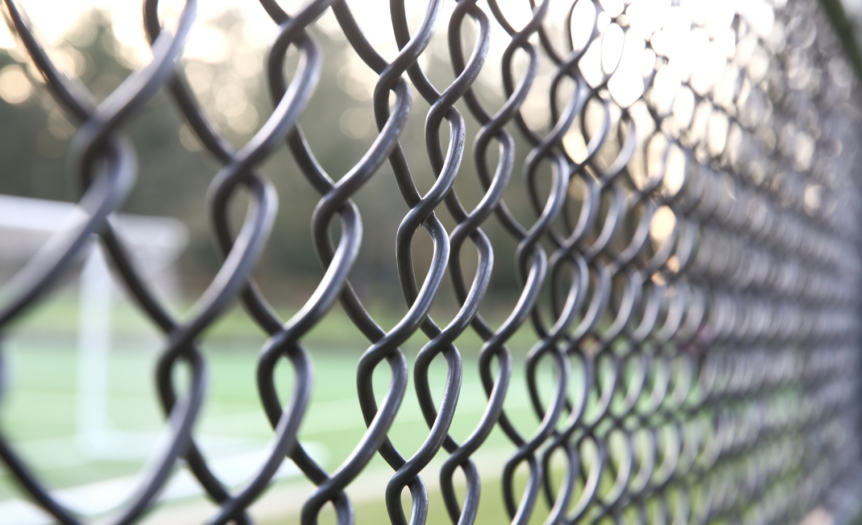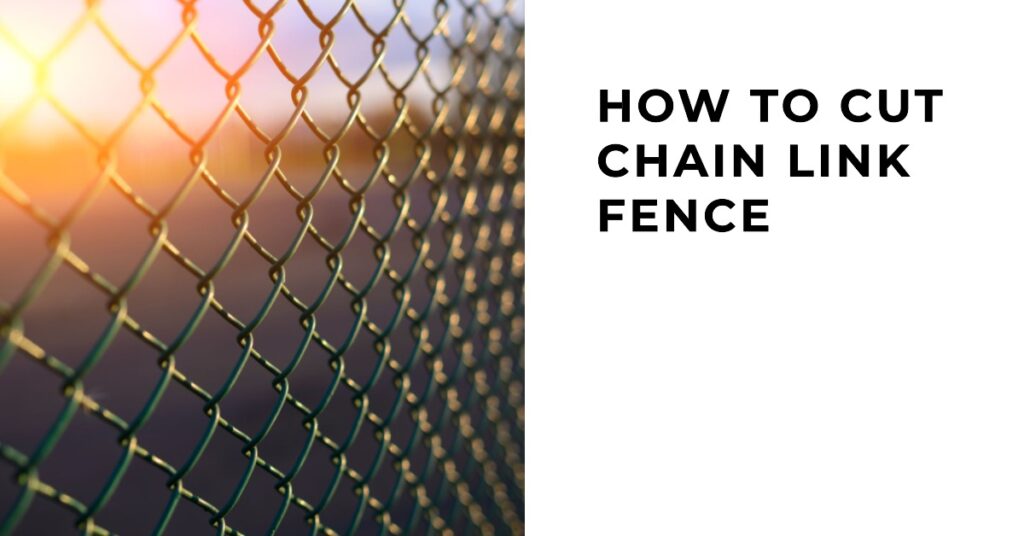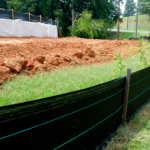Are you in need of a DIY solution for modifying or repairing your chain link fence? Whether it’s changing the height, replacing damaged sections, or repositioning posts, knowing how to cut chain link fences can be an essential skill for any homeowner.
In this blog post, we will provide you with a step-by-step guide on how to cut your chain link fence safely and effectively using various cutting tools available at your disposal.
Understanding The Tools Needed To Cut Chain Link Fence
To properly cut a chain link fence, you’ll need to have the right tools on hand, including bolt cutters, pipe cutters, hacksaw blades, reciprocating saws, and tin snips.
Bolt Cutters
Bolt cutters are essential when it comes to cutting chain link fences, as these powerful tools can easily slice through the metal wires without causing damage to the rest of the fence.
Available in various sizes and designs, bolt cutters feature a compound joint structure, which enables them to exert considerable pressure with little user effort.
To use bolt cutters effectively on a chain link fence, position the cutter’s jaws around the wire at a perpendicular angle and apply even pressure on both handles until the wire is severed.
Keep in mind that larger size bolt cutters may be required for cutting thicker gauge fencing materials; always opt for an appropriate tool based on your project’s demands.
Video Credit( Valrine’s Home Design & Decor)
Pipe Cutters
Pipe cutters are useful tools for cutting metal pipes, including those used in chain link fences. They come in handheld and larger mechanical versions, depending on the size of the pipe being cut.
When using a pipe cutter for fence repair or maintenance, it’s important to choose one that is appropriate for the diameter of your pipes. Selecting a tool with blades that are too small will make cutting difficult and could damage your fence.
Some popular brands include Ridgid and Milwaukee, but you can find many options at your local hardware store or online retailer.
Hacksaw
A hacksaw is a versatile tool that can be used to cut through various materials, including metal. When it comes to cutting a chain link fence, a hacksaw is an excellent option because it allows for precise cuts in tight spaces.
To use a hacksaw effectively, you’ll need the right blade with enough teeth per inch (TPI) to handle the thickness of the fence material.
Position the blade perpendicular to the fence and make slow and steady strokes until you’ve cut through the entire section. Remember to keep your movements smooth and avoid putting too much pressure on the blade, as this can cause it to snap or break prematurely.
Reciprocating Saw
A reciprocating saw is a power tool that can make cutting chain link fence a breeze. With its back and forth motion, this saw can quickly slice through metal pipes or tougher areas of the fence fabric.
To use a reciprocating saw on your chain link fence, make sure to attach the appropriate blade designed for metal-cutting applications. Then carefully guide the saw along your marked line, taking care not to damage any surrounding sections of the fence.
Remember to wear protective gear like safety glasses and gloves while working with power tools for added safety.
Tin Snips
Another tool that can be used to cut chain link fence is tin snips. Tin snips are handheld tools with sharp, angled blades designed for cutting thin and flexible materials like sheet metal and wire mesh.
To use tin snips for cutting chain link fence, start by measuring the section you want to remove and marking it accordingly. Then, carefully position the tin snips over the marked line and apply pressure while making a slow, steady squeeze.
While tin snips can be an effective option for smaller cuts or touch-up work on your fence, they may not be suitable for larger jobs or more complex cuts.
Step-by-Step Guide For Cutting Chain Link Fence
To cut a chain link fence, measure and mark the section you want to remove, then use bolt cutters or a hacksaw to cut the top rail, loosen the tension bands, and finally cut through the fabric before removing the fence section.
Measure And Mark
Before you start cutting your chain link fence, it’s important to measure and mark the area you want to cut. This will ensure that you make a precise cut and don’t end up damaging other parts of the fence.
First, use a measuring tape to determine the exact length of the section you want to cut.
You can also use a level tool to ensure that your markings are straight and even. Once you’ve marked off your cutting area, double-check your measurements to avoid any mistakes before proceeding with cutting the fence.
Cut The Top Rail
Cutting the top rail of a chain link fence is an essential step when removing or adjusting fence height. You will need to use either bolt cutters, reciprocating saw, or hacksaw depending on the size of the rail and your cutting preference.
Make sure to measure and mark where you want to make your cuts before starting.
If using bolt cutters, ensure they’re long enough to reach through each section of the top rail without straining yourself too much. Use slow and steady pressure while cutting through the metal pipe.
For electric-powered tools like a reciprocating saw with a blade appropriate for cutting steel pipes or a hacksaw with tungsten carbide teeth designed for metal piping works well for smooth cuts in even large diameter tubes such as those used as top rails in chain-link fences.
Loosen The Tension Bands
Before you can remove a section of your chain link fence, it’s important to loosen the tension bands that are holding it together. To do this, use pliers or a wrench to loosen the bolts on the bands until they’re no longer tightly secured around the top rail and mesh fabric.
It’s important not to completely remove these parts as they’ll be needed for reinstallation after cutting out your desired fence section. Remember to keep everything organized for easy reassembly later.
It may also be helpful to have an extra set of hands during this step if possible, as some tension can still remain even after loosening the bands.
Cut The Fabric
Now that you have loosened the tension bands, it’s time to cut the fabric. Using your chosen cutting tool (such as bolt cutters, tin snips or a reciprocating saw), carefully cut through the fence fabric where you marked it earlier.
As you cut, be mindful of any cross ties holding the chain link in place between posts. Be sure to remove them gently so as not to damage surrounding fence materials. Once all ties are removed and you’ve made a clean cut through the fabric, carefully remove the entire section of fencing from between the posts.
Remove The Fence Section
Once you’ve cut the top rail and loosened the tension bands, it’s time to remove the fence section you want to replace or repair. Begin by folding back the chain link fabric on either side of where you made your cut.
With a helper holding one end of the fence section steady, use pliers or vise grips to pull out any remaining wire ties attaching it to its neighboring sections.
Once all the ties are removed, carefully lift up and away from both posts at once.
Remember that fences can be heavy and awkwardly shaped – taking care during this step is crucial for safety and avoiding damaging your yard or buildings near the fence line!
Tips And Best Practices For Cutting Chain Link Fences
When cutting a chain link fence, it’s important to wear appropriate safety gear such as gloves and eye protection, select the right tool for the job, double check measurements, handle the fence with care to avoid damage, and consider professional help for complex cuts.
Wear Appropriate Safety Gear
Wearing appropriate safety gear is crucial when cutting chain link fences. It’s important to protect your eyes, hands, and body from flying debris that can cause serious injuries.
In addition to gloves and eyewear, long sleeves and sturdy work boots are also recommended for added protection. Avoid wearing loose clothing that can get caught in the equipment.
Always be aware of your surroundings and avoid distractions while cutting the fence.
Follow The Guidelines For Appropriate Tool Selection
Choosing the right tool for cutting chain link fence is crucial to achieving a clean and precise cut. Before you start your project, consider the type of cut you need to make and select the appropriate tool accordingly.
For example, if you are making a straight or linear cut, tin snips or hacksaws may suffice.
It’s also important to choose tools that are compatible with the thickness of the chain link fence material. Using a tool that is too small or weak could lead to damaging both the tool and fence.
As much as possible, avoid using blunt tools since it could harm your safety as well.
Double Check Your Measurements
Before cutting your chain link fence, it’s essential to ensure that you have accurate measurements. Even the slightest error can lead to a botched job and wasted time and resources.
For example, imagine measuring incorrectly while trying to cut the top rail of your fence. You then proceed with cutting the metal bar only for it not to fit in place when installing due to an incorrect measurement.
Double-checking measurements may seem tedious but doing so can save you time, effort, and money down the line.
Handle The Fence With Care
When it comes to cutting chain link fence, it is important to handle the fence with care. Chain link fences are made of steel wires woven together and can be easily damaged if handled roughly or improperly.
Another thing to keep in mind when handling a chain link fence is its weight. Fences can be heavy, especially if they have been in place for several years and may have rusted or accumulated debris.
Finally, always take extra caution when working near any electrical lines that may be running through the fence posts.
By following these simple tips, you’ll successfully cut your chain link fence while protecting both yourself and your property from harm.
Consider Professional Help For Complex Cuts
It’s important to note that not all fence cuts are created equal. While some can be easily done with the proper tools and a bit of elbow grease, others require more skill and experience.
In cases where you need to make complex or intricate cuts, it’s always best to consider hiring a professional fence contractor.
For instance, if you’re dealing with oddly shaped corners or tight spaces that require precise cuts, it may be difficult for DIY enthusiasts without professional training in fencing to handle these situations competently.
Moreover, if you don’t have any previous experience working with power tools like reciprocating saws or metal grinders, attempting these types of cuts yourself could lead to safety hazards such as injury or damaged property.
Conclusion: Your Guide To Cutting Chain Link Fence Safely And Effectively
Congratulations! You are now equipped with the knowledge and tools needed to cut a chain link fence like a pro. Remember to always wear appropriate safety gear, double-check your measurements, and handle the fence with care.
If you come across any complex cuts or simply prefer to leave it in the hands of professionals, don’t hesitate to seek help. With this guide on your side, cutting chain link fences will be a breeze every time.









